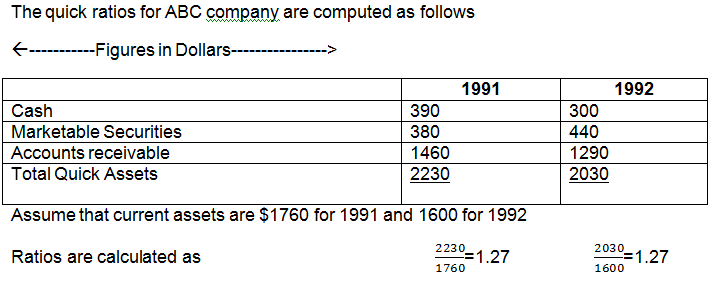
A company that seems to have an acceptable current ratio could be trending toward a situation in which it will struggle to pay its bills. Conversely, a company that may appear to be struggling now could be making good progress toward a healthier current ratio. Modern financial technology (such as Sage Intacct) boosts the speed and accuracy of quick ratio analysis, supporting agile financial management. If the business can produce the same $2,000,000 in sales with a $100,000 inventory investment, the ratio increases to 20. Turnover ratios determine how quickly a business can produce an asset (or buy it into inventory), sell an asset, and collect the cash payment. This list includes many of the common accounts in a business’s balance sheet.
Current Liabilities – Factors to Consider When Analyzing Current Ratio
- The current ratio provides a general indication of a company’s ability to meet its short-term obligations, while the quick ratio provides a more conservative measure of this ability.
- The volume and frequency of trading activities have high impact on the entities’ working capital position and hence on their current ratio number.
- This ratio reflects your business’s capacity to cover expenses, pay employees, and make necessary investments without delay.
- For the last step, we’ll divide the current assets by the current liabilities.
- If you can increase the turnover ratio, you’ll collect cash at a faster rate, and the company’s liquidity will improve.
The current ratio is part of what you need to understand when investing in individual stocks, but those investing in mutual funds or exchange-trade funds needn’t worry about it. The offers that appear on this site are from companies that compensate us. But this compensation does not influence the information we publish, or the reviews that you see on this site. We do not include the universe of companies or financial offers that may be available to you. For example, supplier agreements can make a difference to the number of liabilities and assets. A large retailer like Walmart may negotiate favorable terms with suppliers that allow it to keep inventory for longer periods and have generous payment terms or liabilities.

Three useful financial ratios for business decisions
By leaving a comment on this article, you consent to your comment being made publicly available and visible at the bottom of the article on this blog. For more information on how Sage uses and looks after your personal data and the data protection rights you have, please great ways to green your business read our Privacy Policy. Regular monitoring gives you time to adjust spending, defer expenses, or focus on collections as needed. While the formula is straightforward, the time and effort needed to obtain and verify accurate figures to plug in were often substantial.
Free Course: Understanding Financial Statements
Let us compare the current ratio and the quick ratio, two important financial metrics that provide insights into a company’s liquidity. Minimum levels of current ratio are often defined in loan covenants to protect the interest of the lenders in the event of deteriorating financial position of the borrowers. Increase in current ratio over a period of time may suggest improved liquidity of the company or a more conservative approach to working capital management. Time period analyses of the current ratio must also consider seasonal fluctuations. The current ratio, therefore, is called „current“ because, in contrast to other liquidity ratios, it incorporates all current assets (both liquid and illiquid) and liabilities. If a company’s current ratio is too high, it may indicate it is not using its assets efficiently.
Sample current ratios
The current ratio and quick ratio (also known as the acid-test ratio) are both financial ratios that measure a company’s ability to pay off its short-term obligations. While both ratios are similar, there are some key differences between them. Some industries are seasonal, and the demand for their products or services may vary throughout the year.
Negotiating better supplier payment terms can also improve a company’s current ratio. By extending payment terms or negotiating discounts for early payment, a company can improve its cash flow and increase its ability to meet short-term obligations. However, balancing this strategy with maintaining good relationships with suppliers is essential. Another way to improve a company’s current ratio is to decrease its current liabilities. This can be achieved by paying off short-term debts, negotiating longer payment terms with suppliers, or reducing the amount of outstanding accounts payable. The growth potential of the industry can affect a company’s current ratio.
With minimal inventory, SaaS companies can rely on accounts receivable and cash reserves as primary liquid assets. High inventory levels can slow liquidity, making the quick ratio a valuable tool to focus on truly liquid assets. For example, the inventory listed on a balance sheet shows how much the company initially paid for that inventory. Since companies usually sell inventory for more than it costs to acquire, that can impact the overall ratio.
If so, we could expect a considerable drawdown in future earnings reports (check the maximum drawdown calculator for more details). The calculation method for the quick ratio is more conservative than that of the current ratio, as it excludes inventory from current assets. Investors and stakeholders can use the current ratio to make investment decisions.
Financially healthy companies maintain a positive balance of working capital. The current ratio is a fundamental financial metric that provides valuable insights into a company’s short-term financial health. Imagine it as a financial health checkup for a business, telling us whether it’s equipped to handle its immediate financial responsibilities or if it might be struggling to meet its short-term obligations. Generally, companies would aim to maintain a current ratio of at least 1 to ensure that the value of their current assets cover at least the amount of their short term obligations. However, a current ratio of greater than 1 provides additional cushion against unforeseeable contingencies that may arise in the short term. The current ratio measures a company’s ability to meet short-term obligations.
In contrast, a low current ratio may indicate that a company needs to improve its liquidity before pursuing growth opportunities. As a general rule of thumb, a current ratio between 1.2 and 2 is considered good. This means that a company has at least $1.20 in current assets for every $1 in current liabilities, but no more than $2 in current assets for every $1 in current liabilities.
